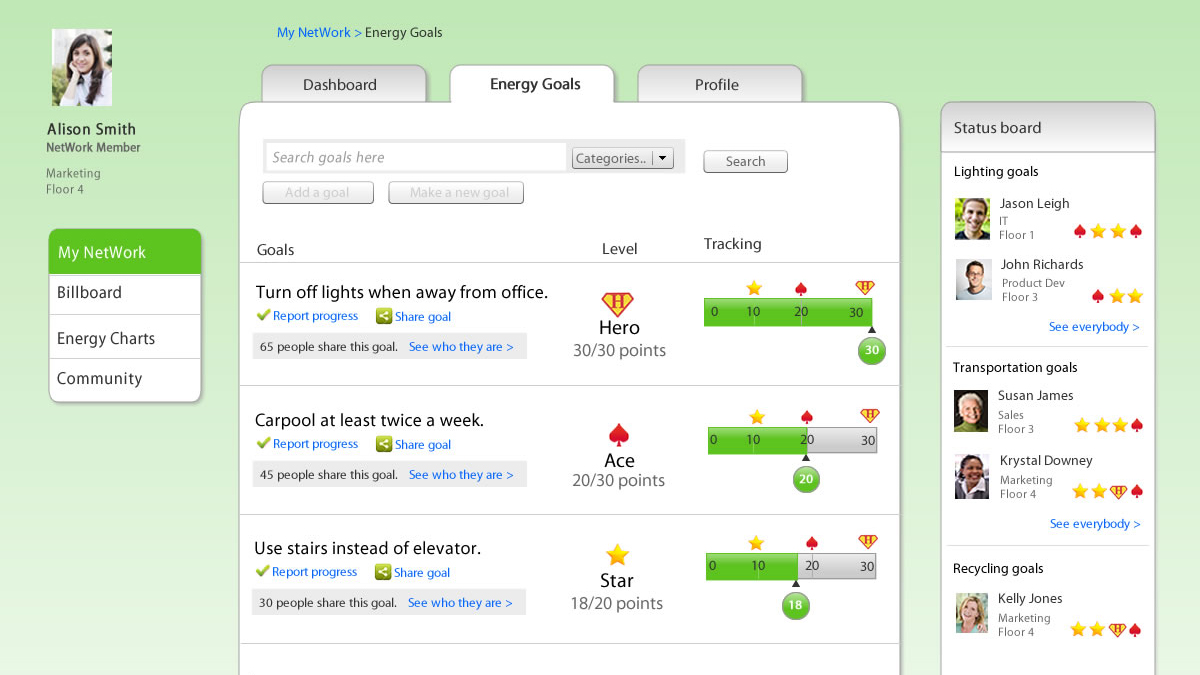Optimizing information feedback to inform and encourage resource saving behavior.
Status: Completed
Funding Sources: CBE Industry Consortium Research Grants
Project Objective
The goal of this work is to identify the optimal methods for displaying building performance information, in order to influence commercial building occupants and managers to reduce resource use.
Project Results
In April of 2011 CBE organized a symposium on Information Visualization in Commercial Buildings: Design, Technology, and Human Behavior. Designers, software developers, researchers, and usability specialists presented various approaches for influencing behavior change, using numerous examples and case studies
Significance to Industry
New data acquisition technologies and information visualization methods provide great opportunities to monitor and display building performance data. Together they provide the building industry with the potential to give feedback to commercial building occupants, managers, and other parties, and to encourage energy-saving behaviors.
A great deal of research has been conducted to evaluate the potential for energy conservation using information feedback to influence occupant behavior in residential buildings. Results of these studies show that immediate energy feedback can result in savings of 5-15%. However little research has been conducted on such feedback in commercial buildings, which present a greater challenge due to their greater complexity and diversity of users.
Research Approach
In spring of 2009, we conducted a preliminary literature review to assess the potential for occupant feedback to reduce energy use in buildings. We also began reviewing commercially available building visualization products to understand capabilities and constraints of these resources. This work was reported in 2010.
The goal of the most recent phase of work was to investigate the potential benefits of using a web-based social network to promote energy awareness, and influence energy-saving behavior of typical office workers. We found that a social network integrated into the workplace environment — allowing people to track their own energy-related activities, to share this information, and to view and react to peers’ activities — can take advantage of social influence to positively affect behavior.
We conducted experiments with 134 participants to test the ability of a prototype application to influence attitudes and behaviors of office workers, and for providing a platform for commercial building operators to better communicate with occupants.
In future phases of this research we will deploy feedback to commercial building occupants using tablet computers to test the effects of various types of energy-related messaging.
Publications and Reports
Lehrer, D., J. Vasudev and S. Kaam, 2014. A Usability Study of a Social Media Prototype for Building Energy feedback and Operations. Proceedings ACEEE Summer Study on Energy Efficiency in Buildings. Pacific Grove, CA, August.
Lehrer, D., and J. Vasudev, 2011. Visualizing Information in Commercial Buildings: A Study of Tools, Expert Users, and Building Occupants. Final report to California Energy Commission-PIER Program. November, 41 pp
Lehrer, D., and J. Vasudev, 2011. Evaluating a Social Media Application for Sustainability in the Workplace, Extended abstract, Proceedings, CHI 2011, Vancouver, May. 6 pp.; doi:10.1145/1979742.1979935
Lehrer, D., and J. Vasudev, 2010. Visualizing Information to Improve Building Performance: A Study of Expert Users. Proceedings, ACEEE Summer Study on Energy Efficiency in Buildings, Pacific Grove, CA, August 15-20. 10 pp.
Lehrer, D., 2009. Research Scoping Report: Visualizing Information in Commercial Buildings. Interim Report to the California Energy Commission (CEC) Public Interest Energy Research (PIER), September.
Lehrer, D., 2009. Visualizing Building Information: Using Information Feedback to Educate and Influence Building Managers and Occupants. Centerline Magazine, January.
Presentations
Lehrer, et al., 2014. A usability study or a social media prototype for building energy feedack and operations.. ACEEE Summer Study on Energy Efficiency in Buildings. August
Lehrer, et al., 2010. Visualizing building information. Presentation to CBE industry partners, April.

